The Role of Nurses in Implementing EBP in Clinical Practice
VerifiedAdded on 2019/11/26
|8
|2303
|145
Essay
AI Summary
This essay explores the critical role of nurses in implementing Evidence-Based Practice (EBP) within clinical settings, emphasizing its significance in improving patient health outcomes. The discussion highlights the benefits of EBP, such as enhanced quality of care, timely and efficient patient care, improved interdisciplinary teamwork, and cost-effectiveness. It outlines the systematic steps involved in applying EBP, including asking relevant questions, searching for research, integrating clinical experience, considering patient preferences, and evaluating outcomes. The essay argues that nurses should be at the forefront of EBP implementation due to their critical thinking skills, adherence to nursing standards, responsibility for professional development, and ability to develop patient care plans based on the latest research. It also stresses the importance of providing nurses with specialized training and support to effectively implement EBP, ensuring they can access information, critically evaluate research, and integrate best practices into their clinical work, which aligns with the Nursing and Midwifery Board of Australia (NMBA) standards and contributes to improved healthcare quality. The essay concludes by reiterating the importance of nurses leading EBP initiatives and the need for supportive resources to foster a conducive environment for enhanced patient care.
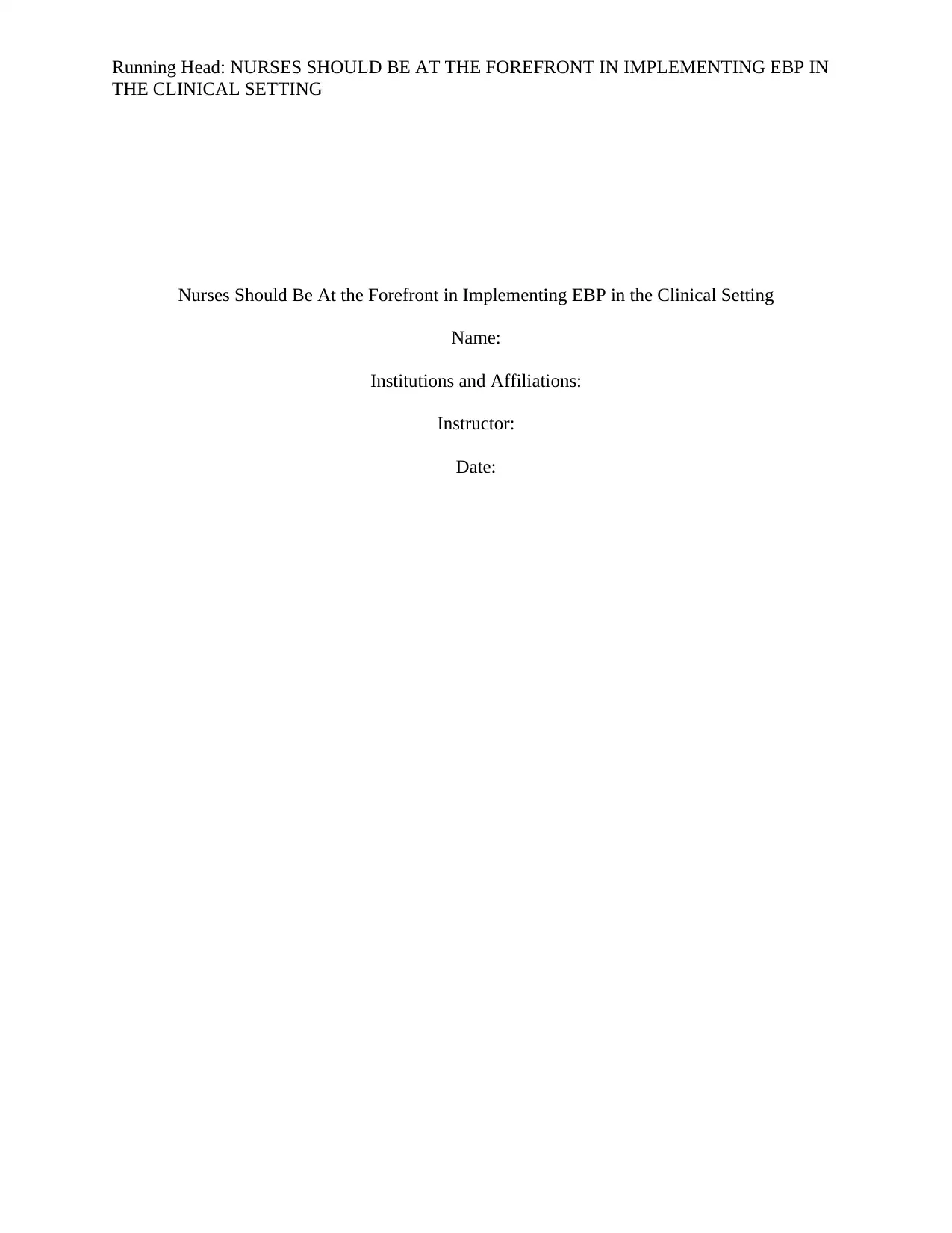
Running Head: NURSES SHOULD BE AT THE FOREFRONT IN IMPLEMENTING EBP IN
THE CLINICAL SETTING
Nurses Should Be At the Forefront in Implementing EBP in the Clinical Setting
Name:
Institutions and Affiliations:
Instructor:
Date:
THE CLINICAL SETTING
Nurses Should Be At the Forefront in Implementing EBP in the Clinical Setting
Name:
Institutions and Affiliations:
Instructor:
Date:
Paraphrase This Document
Need a fresh take? Get an instant paraphrase of this document with our AI Paraphraser
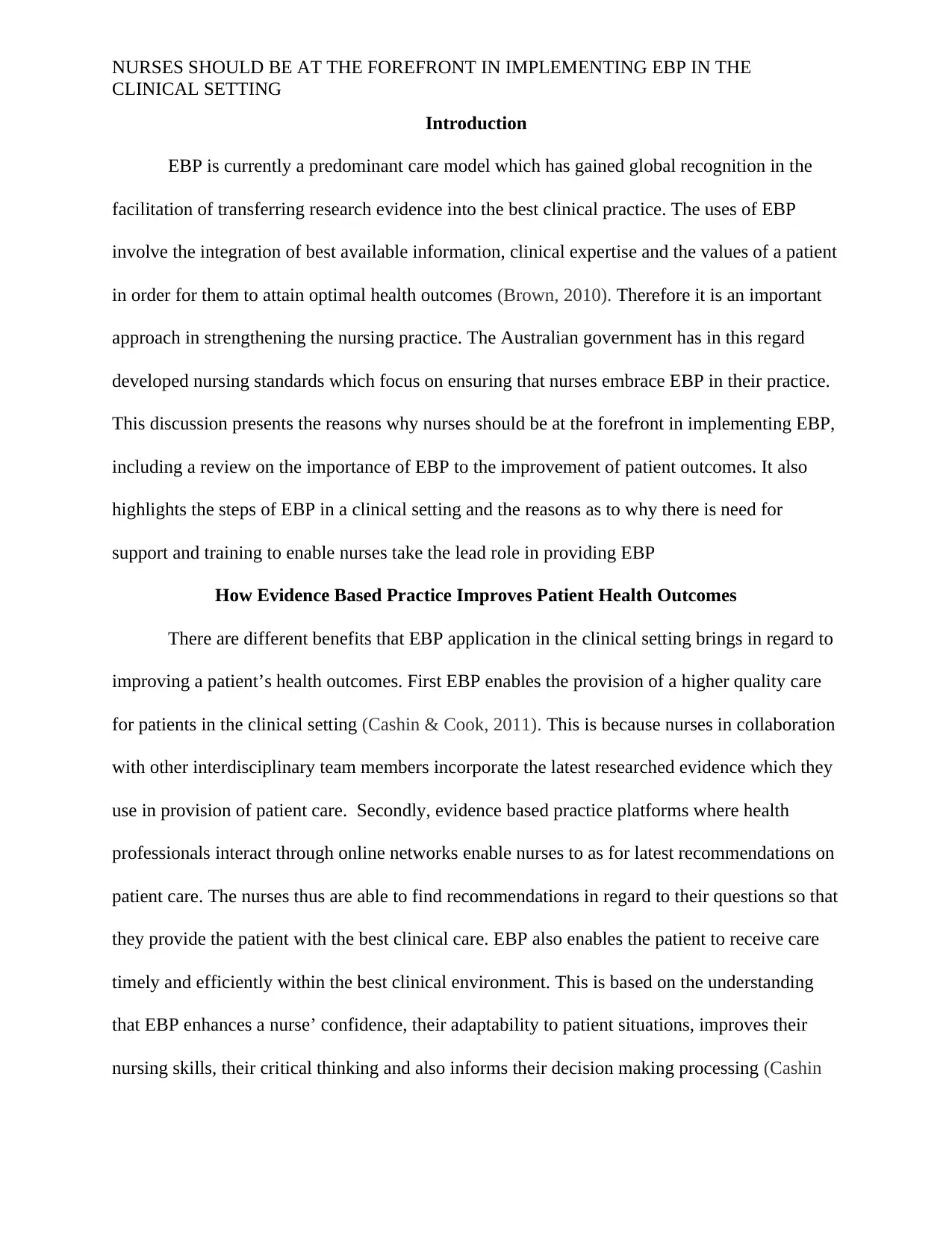
NURSES SHOULD BE AT THE FOREFRONT IN IMPLEMENTING EBP IN THE
CLINICAL SETTING
Introduction
EBP is currently a predominant care model which has gained global recognition in the
facilitation of transferring research evidence into the best clinical practice. The uses of EBP
involve the integration of best available information, clinical expertise and the values of a patient
in order for them to attain optimal health outcomes (Brown, 2010). Therefore it is an important
approach in strengthening the nursing practice. The Australian government has in this regard
developed nursing standards which focus on ensuring that nurses embrace EBP in their practice.
This discussion presents the reasons why nurses should be at the forefront in implementing EBP,
including a review on the importance of EBP to the improvement of patient outcomes. It also
highlights the steps of EBP in a clinical setting and the reasons as to why there is need for
support and training to enable nurses take the lead role in providing EBP
How Evidence Based Practice Improves Patient Health Outcomes
There are different benefits that EBP application in the clinical setting brings in regard to
improving a patient’s health outcomes. First EBP enables the provision of a higher quality care
for patients in the clinical setting (Cashin & Cook, 2011). This is because nurses in collaboration
with other interdisciplinary team members incorporate the latest researched evidence which they
use in provision of patient care. Secondly, evidence based practice platforms where health
professionals interact through online networks enable nurses to as for latest recommendations on
patient care. The nurses thus are able to find recommendations in regard to their questions so that
they provide the patient with the best clinical care. EBP also enables the patient to receive care
timely and efficiently within the best clinical environment. This is based on the understanding
that EBP enhances a nurse’ confidence, their adaptability to patient situations, improves their
nursing skills, their critical thinking and also informs their decision making processing (Cashin
CLINICAL SETTING
Introduction
EBP is currently a predominant care model which has gained global recognition in the
facilitation of transferring research evidence into the best clinical practice. The uses of EBP
involve the integration of best available information, clinical expertise and the values of a patient
in order for them to attain optimal health outcomes (Brown, 2010). Therefore it is an important
approach in strengthening the nursing practice. The Australian government has in this regard
developed nursing standards which focus on ensuring that nurses embrace EBP in their practice.
This discussion presents the reasons why nurses should be at the forefront in implementing EBP,
including a review on the importance of EBP to the improvement of patient outcomes. It also
highlights the steps of EBP in a clinical setting and the reasons as to why there is need for
support and training to enable nurses take the lead role in providing EBP
How Evidence Based Practice Improves Patient Health Outcomes
There are different benefits that EBP application in the clinical setting brings in regard to
improving a patient’s health outcomes. First EBP enables the provision of a higher quality care
for patients in the clinical setting (Cashin & Cook, 2011). This is because nurses in collaboration
with other interdisciplinary team members incorporate the latest researched evidence which they
use in provision of patient care. Secondly, evidence based practice platforms where health
professionals interact through online networks enable nurses to as for latest recommendations on
patient care. The nurses thus are able to find recommendations in regard to their questions so that
they provide the patient with the best clinical care. EBP also enables the patient to receive care
timely and efficiently within the best clinical environment. This is based on the understanding
that EBP enhances a nurse’ confidence, their adaptability to patient situations, improves their
nursing skills, their critical thinking and also informs their decision making processing (Cashin
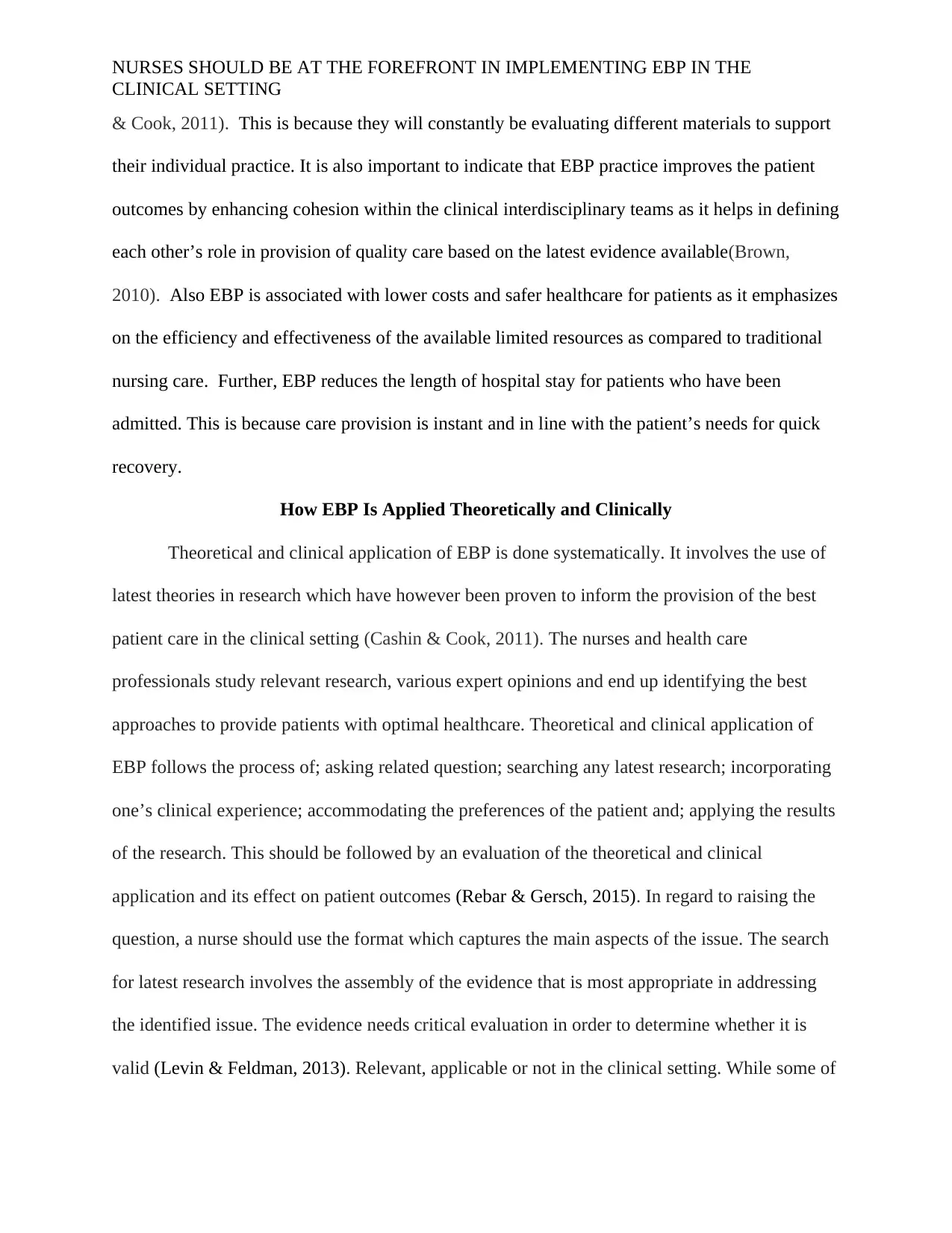
NURSES SHOULD BE AT THE FOREFRONT IN IMPLEMENTING EBP IN THE
CLINICAL SETTING
& Cook, 2011). This is because they will constantly be evaluating different materials to support
their individual practice. It is also important to indicate that EBP practice improves the patient
outcomes by enhancing cohesion within the clinical interdisciplinary teams as it helps in defining
each other’s role in provision of quality care based on the latest evidence available(Brown,
2010). Also EBP is associated with lower costs and safer healthcare for patients as it emphasizes
on the efficiency and effectiveness of the available limited resources as compared to traditional
nursing care. Further, EBP reduces the length of hospital stay for patients who have been
admitted. This is because care provision is instant and in line with the patient’s needs for quick
recovery.
How EBP Is Applied Theoretically and Clinically
Theoretical and clinical application of EBP is done systematically. It involves the use of
latest theories in research which have however been proven to inform the provision of the best
patient care in the clinical setting (Cashin & Cook, 2011). The nurses and health care
professionals study relevant research, various expert opinions and end up identifying the best
approaches to provide patients with optimal healthcare. Theoretical and clinical application of
EBP follows the process of; asking related question; searching any latest research; incorporating
one’s clinical experience; accommodating the preferences of the patient and; applying the results
of the research. This should be followed by an evaluation of the theoretical and clinical
application and its effect on patient outcomes (Rebar & Gersch, 2015). In regard to raising the
question, a nurse should use the format which captures the main aspects of the issue. The search
for latest research involves the assembly of the evidence that is most appropriate in addressing
the identified issue. The evidence needs critical evaluation in order to determine whether it is
valid (Levin & Feldman, 2013). Relevant, applicable or not in the clinical setting. While some of
CLINICAL SETTING
& Cook, 2011). This is because they will constantly be evaluating different materials to support
their individual practice. It is also important to indicate that EBP practice improves the patient
outcomes by enhancing cohesion within the clinical interdisciplinary teams as it helps in defining
each other’s role in provision of quality care based on the latest evidence available(Brown,
2010). Also EBP is associated with lower costs and safer healthcare for patients as it emphasizes
on the efficiency and effectiveness of the available limited resources as compared to traditional
nursing care. Further, EBP reduces the length of hospital stay for patients who have been
admitted. This is because care provision is instant and in line with the patient’s needs for quick
recovery.
How EBP Is Applied Theoretically and Clinically
Theoretical and clinical application of EBP is done systematically. It involves the use of
latest theories in research which have however been proven to inform the provision of the best
patient care in the clinical setting (Cashin & Cook, 2011). The nurses and health care
professionals study relevant research, various expert opinions and end up identifying the best
approaches to provide patients with optimal healthcare. Theoretical and clinical application of
EBP follows the process of; asking related question; searching any latest research; incorporating
one’s clinical experience; accommodating the preferences of the patient and; applying the results
of the research. This should be followed by an evaluation of the theoretical and clinical
application and its effect on patient outcomes (Rebar & Gersch, 2015). In regard to raising the
question, a nurse should use the format which captures the main aspects of the issue. The search
for latest research involves the assembly of the evidence that is most appropriate in addressing
the identified issue. The evidence needs critical evaluation in order to determine whether it is
valid (Levin & Feldman, 2013). Relevant, applicable or not in the clinical setting. While some of
⊘ This is a preview!⊘
Do you want full access?
Subscribe today to unlock all pages.

Trusted by 1+ million students worldwide
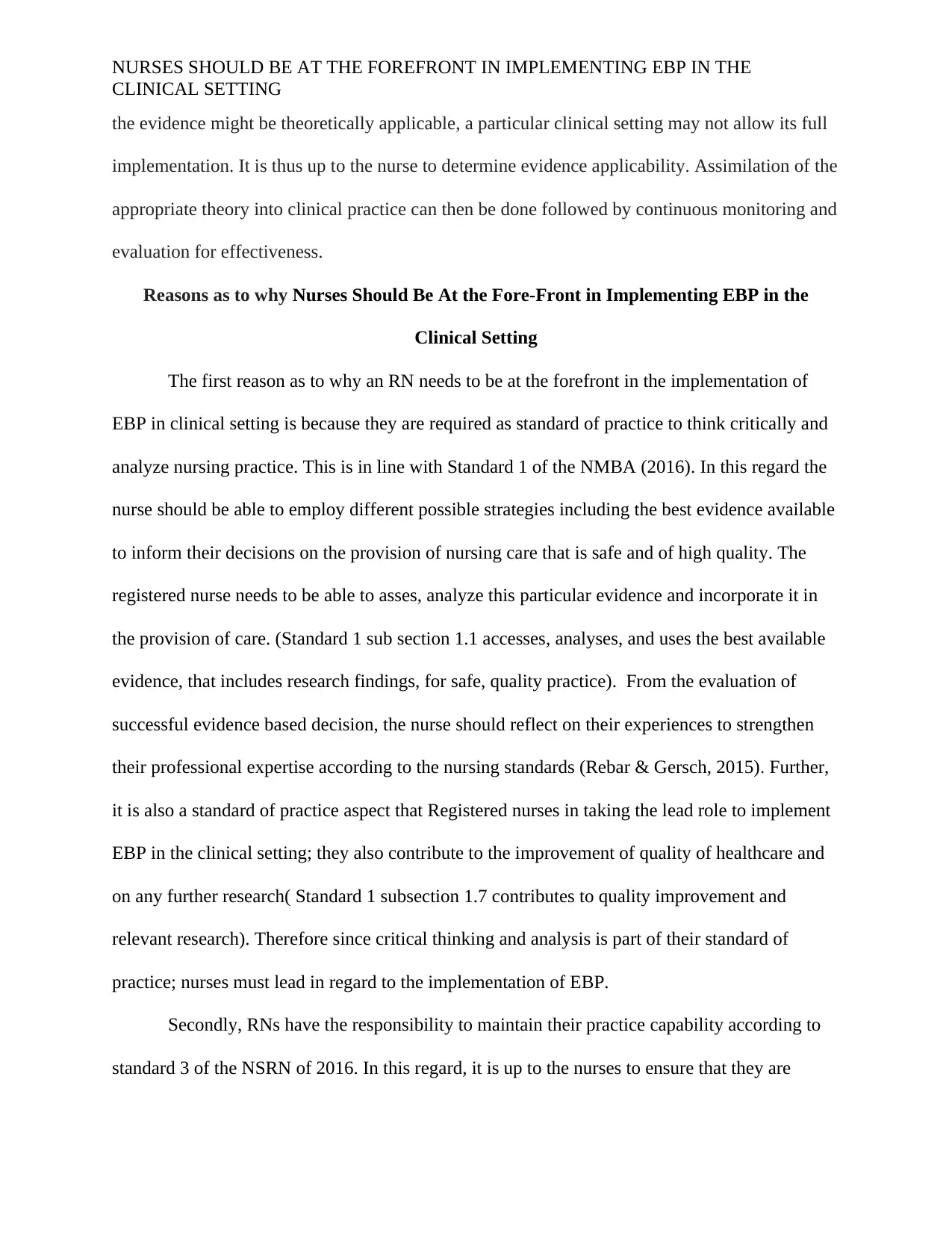
NURSES SHOULD BE AT THE FOREFRONT IN IMPLEMENTING EBP IN THE
CLINICAL SETTING
the evidence might be theoretically applicable, a particular clinical setting may not allow its full
implementation. It is thus up to the nurse to determine evidence applicability. Assimilation of the
appropriate theory into clinical practice can then be done followed by continuous monitoring and
evaluation for effectiveness.
Reasons as to why Nurses Should Be At the Fore-Front in Implementing EBP in the
Clinical Setting
The first reason as to why an RN needs to be at the forefront in the implementation of
EBP in clinical setting is because they are required as standard of practice to think critically and
analyze nursing practice. This is in line with Standard 1 of the NMBA (2016). In this regard the
nurse should be able to employ different possible strategies including the best evidence available
to inform their decisions on the provision of nursing care that is safe and of high quality. The
registered nurse needs to be able to asses, analyze this particular evidence and incorporate it in
the provision of care. (Standard 1 sub section 1.1 accesses, analyses, and uses the best available
evidence, that includes research findings, for safe, quality practice). From the evaluation of
successful evidence based decision, the nurse should reflect on their experiences to strengthen
their professional expertise according to the nursing standards (Rebar & Gersch, 2015). Further,
it is also a standard of practice aspect that Registered nurses in taking the lead role to implement
EBP in the clinical setting; they also contribute to the improvement of quality of healthcare and
on any further research( Standard 1 subsection 1.7 contributes to quality improvement and
relevant research). Therefore since critical thinking and analysis is part of their standard of
practice; nurses must lead in regard to the implementation of EBP.
Secondly, RNs have the responsibility to maintain their practice capability according to
standard 3 of the NSRN of 2016. In this regard, it is up to the nurses to ensure that they are
CLINICAL SETTING
the evidence might be theoretically applicable, a particular clinical setting may not allow its full
implementation. It is thus up to the nurse to determine evidence applicability. Assimilation of the
appropriate theory into clinical practice can then be done followed by continuous monitoring and
evaluation for effectiveness.
Reasons as to why Nurses Should Be At the Fore-Front in Implementing EBP in the
Clinical Setting
The first reason as to why an RN needs to be at the forefront in the implementation of
EBP in clinical setting is because they are required as standard of practice to think critically and
analyze nursing practice. This is in line with Standard 1 of the NMBA (2016). In this regard the
nurse should be able to employ different possible strategies including the best evidence available
to inform their decisions on the provision of nursing care that is safe and of high quality. The
registered nurse needs to be able to asses, analyze this particular evidence and incorporate it in
the provision of care. (Standard 1 sub section 1.1 accesses, analyses, and uses the best available
evidence, that includes research findings, for safe, quality practice). From the evaluation of
successful evidence based decision, the nurse should reflect on their experiences to strengthen
their professional expertise according to the nursing standards (Rebar & Gersch, 2015). Further,
it is also a standard of practice aspect that Registered nurses in taking the lead role to implement
EBP in the clinical setting; they also contribute to the improvement of quality of healthcare and
on any further research( Standard 1 subsection 1.7 contributes to quality improvement and
relevant research). Therefore since critical thinking and analysis is part of their standard of
practice; nurses must lead in regard to the implementation of EBP.
Secondly, RNs have the responsibility to maintain their practice capability according to
standard 3 of the NSRN of 2016. In this regard, it is up to the nurses to ensure that they are
Paraphrase This Document
Need a fresh take? Get an instant paraphrase of this document with our AI Paraphraser
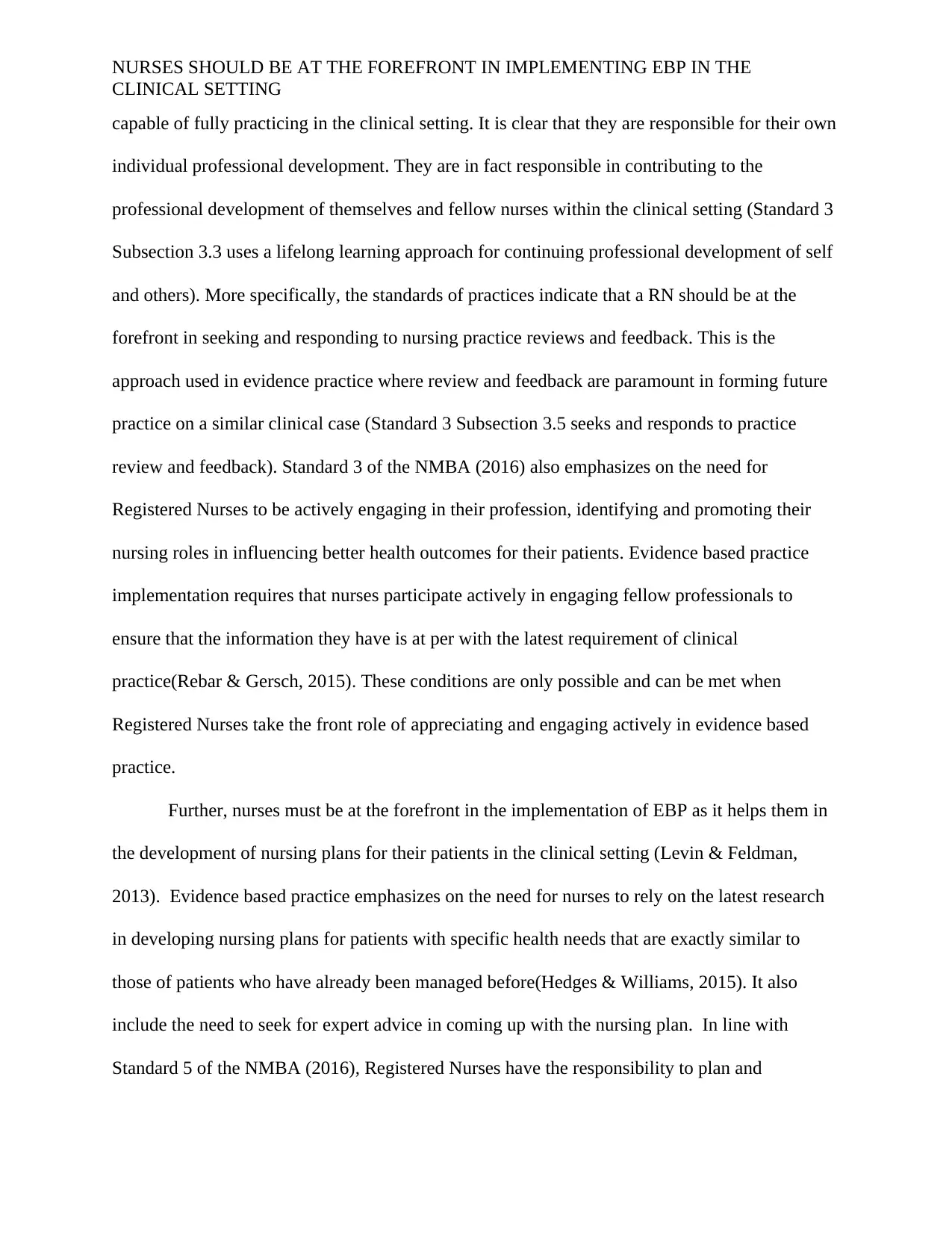
NURSES SHOULD BE AT THE FOREFRONT IN IMPLEMENTING EBP IN THE
CLINICAL SETTING
capable of fully practicing in the clinical setting. It is clear that they are responsible for their own
individual professional development. They are in fact responsible in contributing to the
professional development of themselves and fellow nurses within the clinical setting (Standard 3
Subsection 3.3 uses a lifelong learning approach for continuing professional development of self
and others). More specifically, the standards of practices indicate that a RN should be at the
forefront in seeking and responding to nursing practice reviews and feedback. This is the
approach used in evidence practice where review and feedback are paramount in forming future
practice on a similar clinical case (Standard 3 Subsection 3.5 seeks and responds to practice
review and feedback). Standard 3 of the NMBA (2016) also emphasizes on the need for
Registered Nurses to be actively engaging in their profession, identifying and promoting their
nursing roles in influencing better health outcomes for their patients. Evidence based practice
implementation requires that nurses participate actively in engaging fellow professionals to
ensure that the information they have is at per with the latest requirement of clinical
practice(Rebar & Gersch, 2015). These conditions are only possible and can be met when
Registered Nurses take the front role of appreciating and engaging actively in evidence based
practice.
Further, nurses must be at the forefront in the implementation of EBP as it helps them in
the development of nursing plans for their patients in the clinical setting (Levin & Feldman,
2013). Evidence based practice emphasizes on the need for nurses to rely on the latest research
in developing nursing plans for patients with specific health needs that are exactly similar to
those of patients who have already been managed before(Hedges & Williams, 2015). It also
include the need to seek for expert advice in coming up with the nursing plan. In line with
Standard 5 of the NMBA (2016), Registered Nurses have the responsibility to plan and
CLINICAL SETTING
capable of fully practicing in the clinical setting. It is clear that they are responsible for their own
individual professional development. They are in fact responsible in contributing to the
professional development of themselves and fellow nurses within the clinical setting (Standard 3
Subsection 3.3 uses a lifelong learning approach for continuing professional development of self
and others). More specifically, the standards of practices indicate that a RN should be at the
forefront in seeking and responding to nursing practice reviews and feedback. This is the
approach used in evidence practice where review and feedback are paramount in forming future
practice on a similar clinical case (Standard 3 Subsection 3.5 seeks and responds to practice
review and feedback). Standard 3 of the NMBA (2016) also emphasizes on the need for
Registered Nurses to be actively engaging in their profession, identifying and promoting their
nursing roles in influencing better health outcomes for their patients. Evidence based practice
implementation requires that nurses participate actively in engaging fellow professionals to
ensure that the information they have is at per with the latest requirement of clinical
practice(Rebar & Gersch, 2015). These conditions are only possible and can be met when
Registered Nurses take the front role of appreciating and engaging actively in evidence based
practice.
Further, nurses must be at the forefront in the implementation of EBP as it helps them in
the development of nursing plans for their patients in the clinical setting (Levin & Feldman,
2013). Evidence based practice emphasizes on the need for nurses to rely on the latest research
in developing nursing plans for patients with specific health needs that are exactly similar to
those of patients who have already been managed before(Hedges & Williams, 2015). It also
include the need to seek for expert advice in coming up with the nursing plan. In line with
Standard 5 of the NMBA (2016), Registered Nurses have the responsibility to plan and
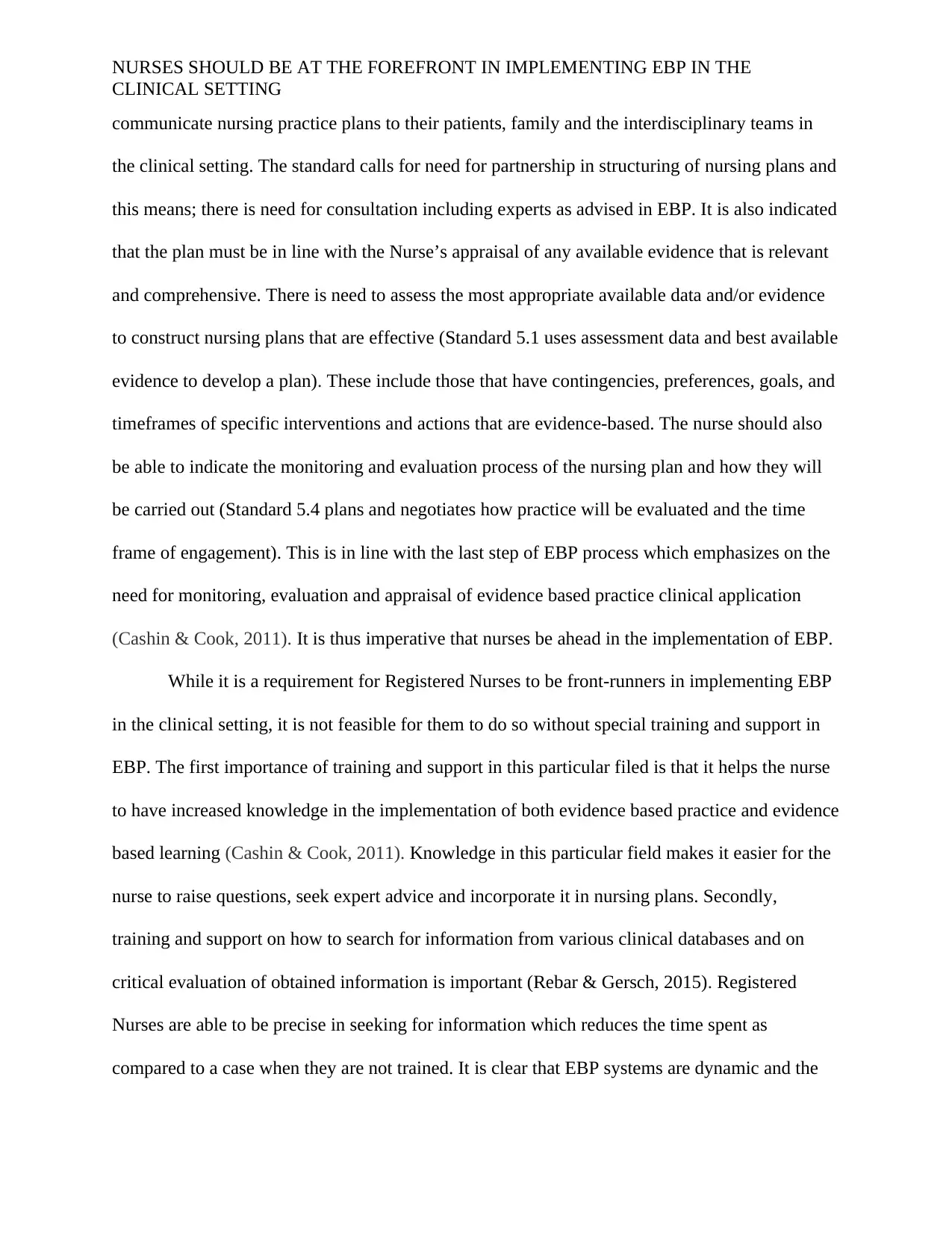
NURSES SHOULD BE AT THE FOREFRONT IN IMPLEMENTING EBP IN THE
CLINICAL SETTING
communicate nursing practice plans to their patients, family and the interdisciplinary teams in
the clinical setting. The standard calls for need for partnership in structuring of nursing plans and
this means; there is need for consultation including experts as advised in EBP. It is also indicated
that the plan must be in line with the Nurse’s appraisal of any available evidence that is relevant
and comprehensive. There is need to assess the most appropriate available data and/or evidence
to construct nursing plans that are effective (Standard 5.1 uses assessment data and best available
evidence to develop a plan). These include those that have contingencies, preferences, goals, and
timeframes of specific interventions and actions that are evidence-based. The nurse should also
be able to indicate the monitoring and evaluation process of the nursing plan and how they will
be carried out (Standard 5.4 plans and negotiates how practice will be evaluated and the time
frame of engagement). This is in line with the last step of EBP process which emphasizes on the
need for monitoring, evaluation and appraisal of evidence based practice clinical application
(Cashin & Cook, 2011). It is thus imperative that nurses be ahead in the implementation of EBP.
While it is a requirement for Registered Nurses to be front-runners in implementing EBP
in the clinical setting, it is not feasible for them to do so without special training and support in
EBP. The first importance of training and support in this particular filed is that it helps the nurse
to have increased knowledge in the implementation of both evidence based practice and evidence
based learning (Cashin & Cook, 2011). Knowledge in this particular field makes it easier for the
nurse to raise questions, seek expert advice and incorporate it in nursing plans. Secondly,
training and support on how to search for information from various clinical databases and on
critical evaluation of obtained information is important (Rebar & Gersch, 2015). Registered
Nurses are able to be precise in seeking for information which reduces the time spent as
compared to a case when they are not trained. It is clear that EBP systems are dynamic and the
CLINICAL SETTING
communicate nursing practice plans to their patients, family and the interdisciplinary teams in
the clinical setting. The standard calls for need for partnership in structuring of nursing plans and
this means; there is need for consultation including experts as advised in EBP. It is also indicated
that the plan must be in line with the Nurse’s appraisal of any available evidence that is relevant
and comprehensive. There is need to assess the most appropriate available data and/or evidence
to construct nursing plans that are effective (Standard 5.1 uses assessment data and best available
evidence to develop a plan). These include those that have contingencies, preferences, goals, and
timeframes of specific interventions and actions that are evidence-based. The nurse should also
be able to indicate the monitoring and evaluation process of the nursing plan and how they will
be carried out (Standard 5.4 plans and negotiates how practice will be evaluated and the time
frame of engagement). This is in line with the last step of EBP process which emphasizes on the
need for monitoring, evaluation and appraisal of evidence based practice clinical application
(Cashin & Cook, 2011). It is thus imperative that nurses be ahead in the implementation of EBP.
While it is a requirement for Registered Nurses to be front-runners in implementing EBP
in the clinical setting, it is not feasible for them to do so without special training and support in
EBP. The first importance of training and support in this particular filed is that it helps the nurse
to have increased knowledge in the implementation of both evidence based practice and evidence
based learning (Cashin & Cook, 2011). Knowledge in this particular field makes it easier for the
nurse to raise questions, seek expert advice and incorporate it in nursing plans. Secondly,
training and support on how to search for information from various clinical databases and on
critical evaluation of obtained information is important (Rebar & Gersch, 2015). Registered
Nurses are able to be precise in seeking for information which reduces the time spent as
compared to a case when they are not trained. It is clear that EBP systems are dynamic and the
⊘ This is a preview!⊘
Do you want full access?
Subscribe today to unlock all pages.

Trusted by 1+ million students worldwide
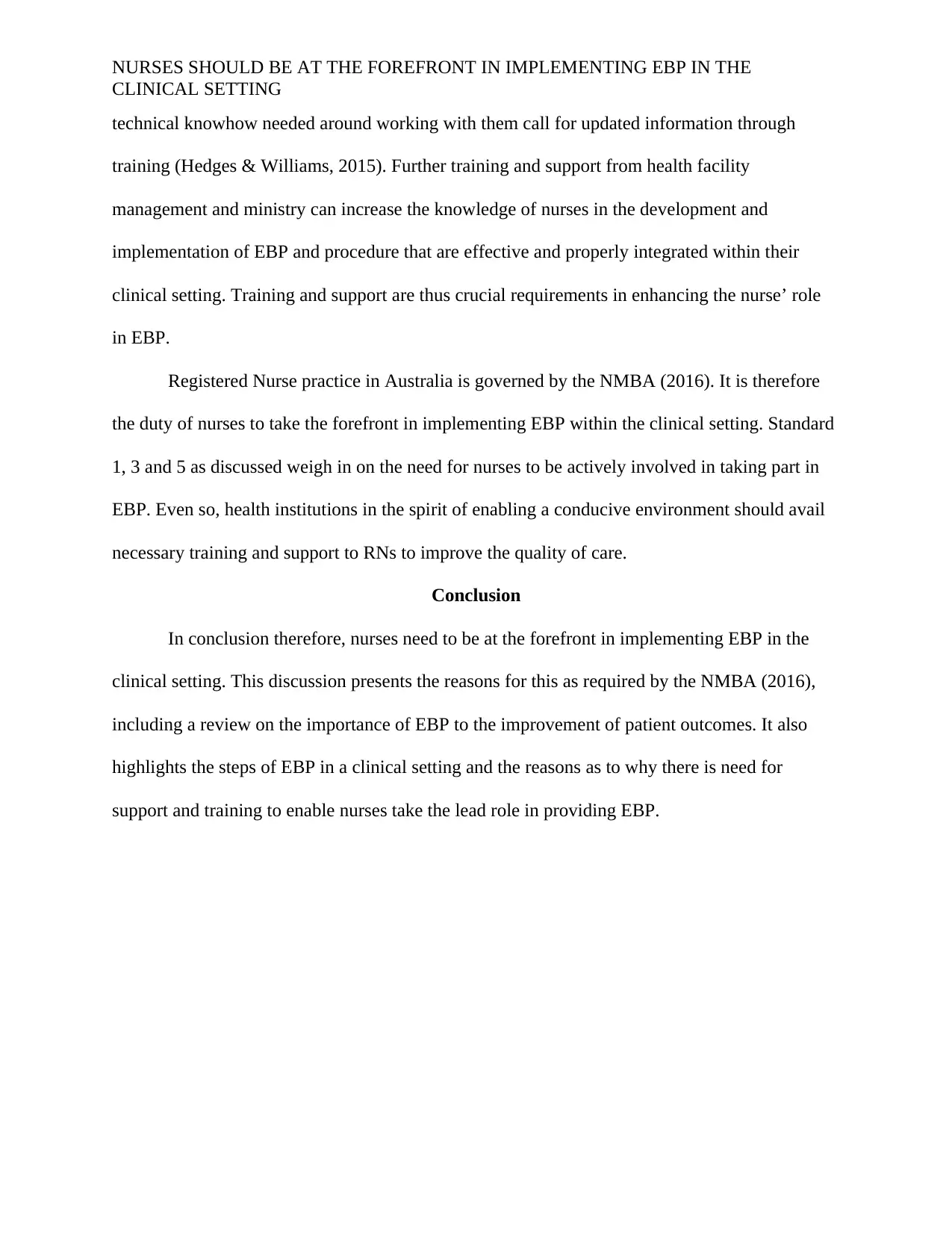
NURSES SHOULD BE AT THE FOREFRONT IN IMPLEMENTING EBP IN THE
CLINICAL SETTING
technical knowhow needed around working with them call for updated information through
training (Hedges & Williams, 2015). Further training and support from health facility
management and ministry can increase the knowledge of nurses in the development and
implementation of EBP and procedure that are effective and properly integrated within their
clinical setting. Training and support are thus crucial requirements in enhancing the nurse’ role
in EBP.
Registered Nurse practice in Australia is governed by the NMBA (2016). It is therefore
the duty of nurses to take the forefront in implementing EBP within the clinical setting. Standard
1, 3 and 5 as discussed weigh in on the need for nurses to be actively involved in taking part in
EBP. Even so, health institutions in the spirit of enabling a conducive environment should avail
necessary training and support to RNs to improve the quality of care.
Conclusion
In conclusion therefore, nurses need to be at the forefront in implementing EBP in the
clinical setting. This discussion presents the reasons for this as required by the NMBA (2016),
including a review on the importance of EBP to the improvement of patient outcomes. It also
highlights the steps of EBP in a clinical setting and the reasons as to why there is need for
support and training to enable nurses take the lead role in providing EBP.
CLINICAL SETTING
technical knowhow needed around working with them call for updated information through
training (Hedges & Williams, 2015). Further training and support from health facility
management and ministry can increase the knowledge of nurses in the development and
implementation of EBP and procedure that are effective and properly integrated within their
clinical setting. Training and support are thus crucial requirements in enhancing the nurse’ role
in EBP.
Registered Nurse practice in Australia is governed by the NMBA (2016). It is therefore
the duty of nurses to take the forefront in implementing EBP within the clinical setting. Standard
1, 3 and 5 as discussed weigh in on the need for nurses to be actively involved in taking part in
EBP. Even so, health institutions in the spirit of enabling a conducive environment should avail
necessary training and support to RNs to improve the quality of care.
Conclusion
In conclusion therefore, nurses need to be at the forefront in implementing EBP in the
clinical setting. This discussion presents the reasons for this as required by the NMBA (2016),
including a review on the importance of EBP to the improvement of patient outcomes. It also
highlights the steps of EBP in a clinical setting and the reasons as to why there is need for
support and training to enable nurses take the lead role in providing EBP.
Paraphrase This Document
Need a fresh take? Get an instant paraphrase of this document with our AI Paraphraser
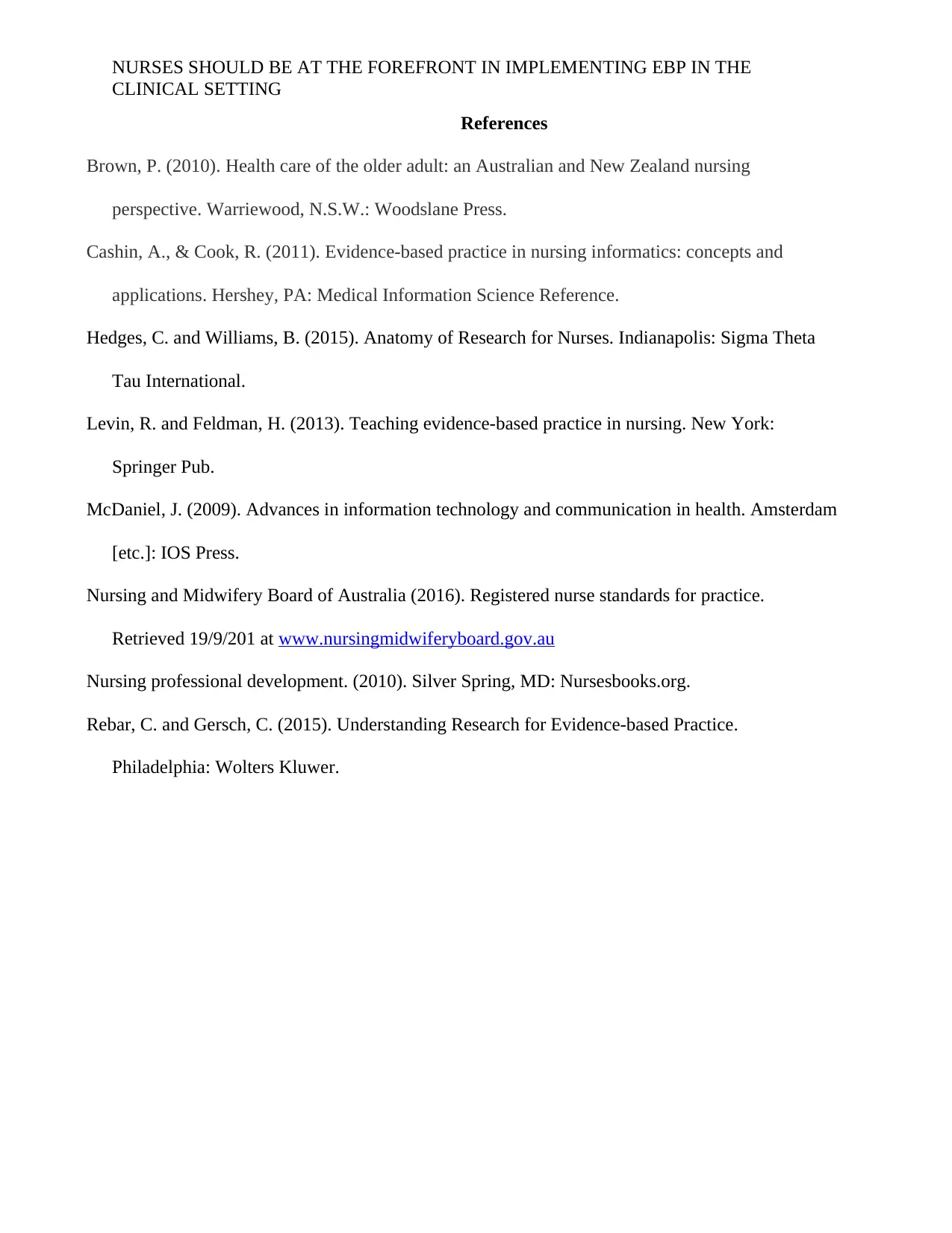
NURSES SHOULD BE AT THE FOREFRONT IN IMPLEMENTING EBP IN THE
CLINICAL SETTING
References
Brown, P. (2010). Health care of the older adult: an Australian and New Zealand nursing
perspective. Warriewood, N.S.W.: Woodslane Press.
Cashin, A., & Cook, R. (2011). Evidence-based practice in nursing informatics: concepts and
applications. Hershey, PA: Medical Information Science Reference.
Hedges, C. and Williams, B. (2015). Anatomy of Research for Nurses. Indianapolis: Sigma Theta
Tau International.
Levin, R. and Feldman, H. (2013). Teaching evidence-based practice in nursing. New York:
Springer Pub.
McDaniel, J. (2009). Advances in information technology and communication in health. Amsterdam
[etc.]: IOS Press.
Nursing and Midwifery Board of Australia (2016). Registered nurse standards for practice.
Retrieved 19/9/201 at www.nursingmidwiferyboard.gov.au
Nursing professional development. (2010). Silver Spring, MD: Nursesbooks.org.
Rebar, C. and Gersch, C. (2015). Understanding Research for Evidence-based Practice.
Philadelphia: Wolters Kluwer.
CLINICAL SETTING
References
Brown, P. (2010). Health care of the older adult: an Australian and New Zealand nursing
perspective. Warriewood, N.S.W.: Woodslane Press.
Cashin, A., & Cook, R. (2011). Evidence-based practice in nursing informatics: concepts and
applications. Hershey, PA: Medical Information Science Reference.
Hedges, C. and Williams, B. (2015). Anatomy of Research for Nurses. Indianapolis: Sigma Theta
Tau International.
Levin, R. and Feldman, H. (2013). Teaching evidence-based practice in nursing. New York:
Springer Pub.
McDaniel, J. (2009). Advances in information technology and communication in health. Amsterdam
[etc.]: IOS Press.
Nursing and Midwifery Board of Australia (2016). Registered nurse standards for practice.
Retrieved 19/9/201 at www.nursingmidwiferyboard.gov.au
Nursing professional development. (2010). Silver Spring, MD: Nursesbooks.org.
Rebar, C. and Gersch, C. (2015). Understanding Research for Evidence-based Practice.
Philadelphia: Wolters Kluwer.
1 out of 8
Related Documents
Your All-in-One AI-Powered Toolkit for Academic Success.
+13062052269
info@desklib.com
Available 24*7 on WhatsApp / Email
![[object Object]](/_next/static/media/star-bottom.7253800d.svg)
Unlock your academic potential
Copyright © 2020–2025 A2Z Services. All Rights Reserved. Developed and managed by ZUCOL.





